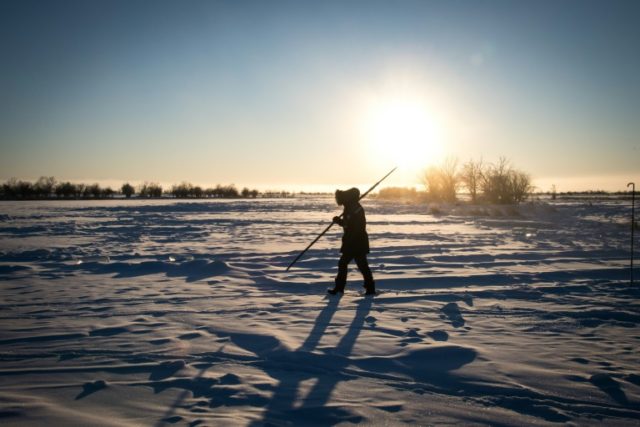Yakutsk (Russia) (AFP) – The Earth’s vast tracts of permafrost hold billions of tonnes of planet-heating greenhouse gases that scientists warn will be released by global warming, along with diseases long locked into the ice.
Here is some background.
– A quarter of the north –
Permafrost — soil that is frozen, although not necessarily permanently as it name implies — is found mostly in the Northern Hemisphere, where it covers about a quarter of exposed land and is generally thousands of years old.
It covers a wide belt between the Arctic Circle and boreal forests, spanning Alaska, Canada, northern Europe and Russia.
Permafrost exists to a lesser degree in the Southern Hemisphere where there is less ground to freeze, including in the South American Andes and below Antarctica.
It can vary in depth from a few metres to more than 100.
– Tonnes of locked-in carbon –
Locked into the permafrost is an estimated 1.7 trillion tonnes of carbon in the form of frozen organic matter — the remains of rotted plants and long-dead animals trapped in sediment and later covered by ice sheets.
When permafrost thaws, this matter warms up and decomposes, eventually releasing the carbon that it holds as carbon dioxide (CO2) and methane, gases which have a greenhouse warming effect on the planet.
Permafrost soils contain roughly twice as much carbon — mainly in the form of methane and CO2 — as Earth’s atmosphere.
Most of the carbon stocks are thought to reside fairly close to the surface.
– Vicious circle of warming –
The release of greenhouse gases threatens a vicious circle in the warming of the Earth, jeopardising the objective set in the 2015 Paris Agreement to strive to limit the rise in temperature to 1.5 degrees Celsius (2.7 degrees Fahrenheit) above pre-industrial levels.
CO2 is the most abundant greenhouse gas blamed for global warming but methane is 25 times more efficient at trapping heat.
Adding these into the atmosphere will spur further warming and ice melt, which will in turn cause more thawing of the permafrost and free up more locked-up carbon.
Even if global warming were stabilised at around 2 C, research points to a 30-percent loss of permafrost by 2100, researcher Susan Natali of the Woods Hole Research Center told 2015 climate talks in Bonn.
This could reach up to 70 percent assuming emissions continue on their current trajectory, her research said, warning that “emissions from permafrost could lead to out-of-control global warming”.
– Frozen diseases? –
The thawing of the permafrost also threatens to unlock disease-causing bacteria and viruses long trapped in the ice.
There have already been some cases of this happening. In 2016 a child died in Russia’s far northern Siberia in an outbreak of anthrax that scientists said seemed to have come from the corpses of infected reindeers buried 70 years before but uncovered by melting permafrost.
Released from the ice, the anthrax seems to have been passed to grazing herds.
Scientists have also warned that other dormant pathogens entombed in frozen soil may be roused by global warming, such as from old smallpox graves.
In 2014 scientists revived a giant but harmless virus, dubbed Pithovirus sibericum, that had been locked in the Siberian permafrost for more than 30,000 years.
– Risks to roads, pipelines –
A permafrost thaw could be a boon for the oil and mining industries, providing access to previously difficult-to-reach reserves.
But it also presents a serious and costly threat to infrastructure, risking mudslides and damage to buildings, roads and oil pipelines.
A Greenpeace report published in 2009 said thawing soil in Russia’s permafrost zones caused buildings, bridges and pipelines to deform and collapse, costing up to 1.3 billion euros (nearly $1.5 billion) a year in repairs in western Siberia.

COMMENTS
Please let us know if you're having issues with commenting.